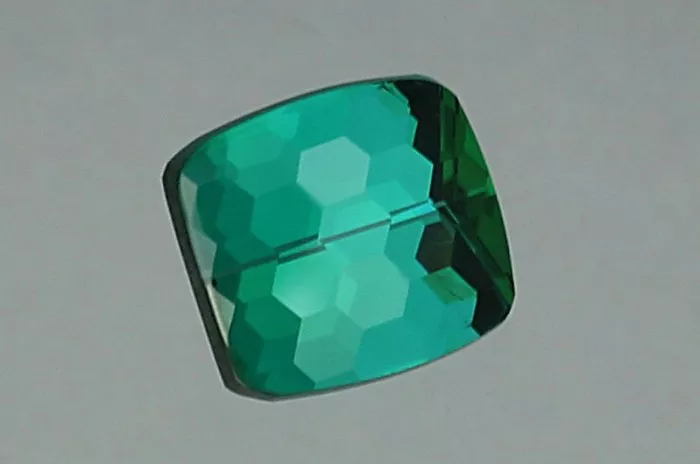Green tourmaline and epidote are two distinct minerals that are often confused due to their similar green coloration. However, they have different chemical compositions, crystal structures, and physical properties. Understanding the differences between these two minerals is crucial for jewelers, collectors, and enthusiasts.
Chemical Composition
Green Tourmaline
Green tourmaline is a complex borosilicate mineral with the general formula XY3Z6(BO3)3Si6O18V3W, where X can be Na+, Ca2+, K+, or a vacancy; Y can be Li+, Mg2+, Fe2+, Fe3+, Mn2+, Al3+, Ti4+, Cr3+, V3+, or a vacancy; and Z can be Al3+, Mg2+, Fe3+, Cr3+, V3+ . The presence of different elements in the formula can lead to variations in color, with chromium and vanadium often contributing to the green hue.
The chemical composition of green tourmaline is responsible for its hardness, which typically ranges from 7 to 7.5 on the Mohs scale, making it a relatively durable gemstone .
Epidote
Epidote is a calcium aluminum iron silicate hydroxide mineral with the chemical formula Ca2(Al,Fe)3(SiO4)3(OH). The presence of iron in the formula can cause the mineral to have a greenish color, which is why it is sometimes mistaken for green tourmaline .
Epidote has a hardness of about 6 to 7 on the Mohs scale, which is slightly less than that of green tourmaline .
Crystal Structure
Green Tourmaline
Green tourmaline has a trigonal crystal system, which means it has three-fold symmetry. Its crystals are often elongated and prismatic, with a characteristic triangular cross-section. The crystal structure of tourmaline is complex, with a framework of silicon-oxygen tetrahedra and boron-oxygen triangles .
The crystal structure of green tourmaline can affect its optical properties, such as its pleochroism, which is the ability to display different colors when viewed from different angles.
Epidote
Epidote has a monoclinic crystal system, which means it has two-fold symmetry. Its crystals are typically prismatic or tabular, with a characteristic cleavage parallel to the basal plane. The crystal structure of epidote is also complex, with chains of silicon-oxygen tetrahedra and aluminum-oxygen octahedra .
The crystal structure of epidote can affect its physical properties, such as its cleavage and fracture, which are important factors in gemstone cutting.
Physical Properties
Green Tourmaline
Green tourmaline has a hardness of 7 to 7.5 on the Mohs scale, which makes it suitable for use in jewelry. It has a specific gravity of about 3.06 to 3.10, which is relatively high compared to other gemstones .
The color of green tourmaline can vary from a light, minty green to a deep, emerald-like green, depending on the presence of different trace elements. It also has a vitreous luster and is often transparent to translucent.
Epidote
Epidote has a hardness of 6 to 7 on the Mohs scale, which is slightly less than that of green tourmaline. It has a specific gravity of about 3.25 to 3.50, which is higher than that of green tourmaline .
The color of epidote can range from yellowish-green to pistachio-green, depending on the amount of iron present. It has a vitreous to resinous luster and is often translucent to opaque.
Occurrence and Geological Setting
Green Tourmaline
Green tourmaline is often found in pegmatites, which are coarse-grained igneous rocks that form during the late stages of magma crystallization. It can also be found in hydrothermal veins and metamorphic rocks. Some of the most well-known sources of green tourmaline include Madagascar, Mozambique, and Tanzania .
In pegmatites, green tourmaline can be associated with other minerals such as quartz, feldspar, and mica. The geological setting of green tourmaline can affect its quality and availability.
Epidote
Epidote is a common mineral in metamorphic rocks, particularly those that have undergone low-temperature hydrothermal alteration. It can also be found in igneous rocks and sedimentary deposits. Epidote is often associated with other minerals such as quartz, feldspar, and amphibole .
The geological setting of epidote can affect its color and quality. For example, epidote from different regions may have different shades of green due to variations in the iron content.
Gemological Significance
Green Tourmaline
Green tourmaline is a popular gemstone due to its vibrant green color and relative durability. It is often used in jewelry, particularly in rings, pendants, and earrings. Green tourmaline is also believed to have certain energetic properties, such as promoting emotional healing and enhancing love and compassion .
The quality of green tourmaline can be assessed based on factors such as color, clarity, cut, and carat weight. High-quality green tourmaline can command a high price in the gemstone market.
Epidote
Epidote is not as commonly used in jewelry as green tourmaline, but it can be used in ornamental pieces and as a collector’s item. Its green color can be attractive, but its lower hardness and less desirable luster compared to green tourmaline limit its use in fine jewelry .
Epidote can also be used in geological studies as a provenance indicator, as its isotopic and trace element compositions can provide information about the source rocks from which it was derived .
Conclusion
In conclusion, green tourmaline and epidote are two distinct minerals with different chemical compositions, crystal structures, and physical properties. While they may share a similar green color, they are not the same. Green tourmaline is a complex borosilicate mineral with a trigonal crystal system, a hardness of 7 to 7.5, and is often used in jewelry. Epidote, on the other hand, is a calcium aluminum iron silicate hydroxide mineral with a monoclinic crystal system, a hardness of 6 to 7, and is less commonly used in jewelry. Understanding these differences is important for jewelers, collectors, and enthusiasts who are interested in these minerals.
Related topic:
- When Should You Not Wear Tourmaline
- Does Pink Tourmaline Fade?
- Tourmaline Vs Obsidian:Which One Should You Choose?


